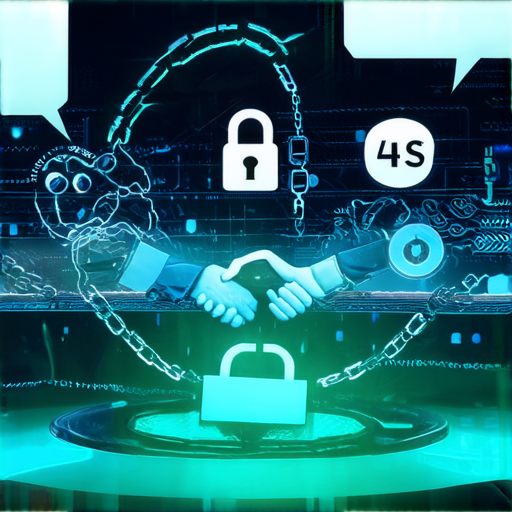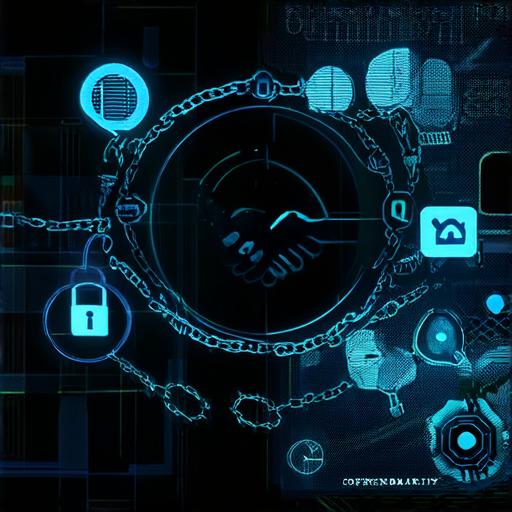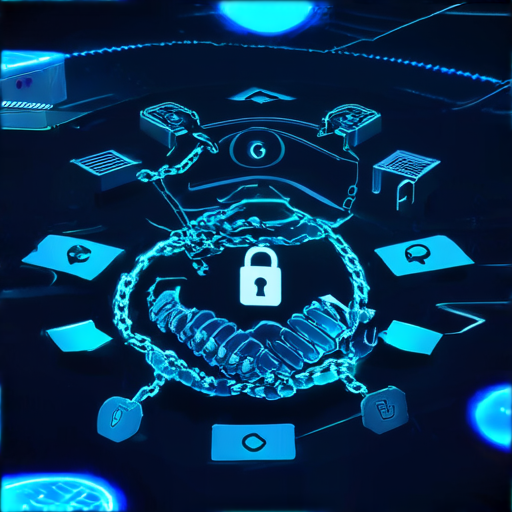In an era where the internet has become an integral part of our daily lives, ensuring internet safety tips for users has never been more critical. Whether you’re a casual user or someone who navigates the digital realm frequently, understanding how to stay safe online is no longer optional but a necessity. From protecting your personal information to safeguarding your devices, the need for reliable safety online rules extends across all demographics, including students, professionals, and families.

10 Rules of eSafety
We at BlindBrowser.com have compiled these essential eSafety rules to help you navigate the digital world safely and securely:
- Password Management:** Never reuse passwords across multiple accounts. Use a password manager to create unique, strong passwords for each platform.
- Two-Factor Authentication:** Enable 2FA for your critical accounts to add an extra layer of security beyond just a password.
- Public Wi-Fi Caution:** Avoid sensitive transactions on public Wi-Fi. Always connect through a VPN if possible.
- Software Updates:** Regularly update your devices and applications to patch vulnerabilities that hackers might exploit.
- Phishing Awareness:** Be cautious of suspicious emails, messages, or links. Verify the sender before clicking or sharing personal info.
- Encrypted Communication:** Use encrypted messaging apps like Signal or WhatsApp to protect your conversations from prying eyes.
- Privacy Settings:** Adjust your social media and online account settings to limit who can see your location, photos, and personal details.
- Backup Data:** Regularly backup important files to an external drive or cloud storage in case of data loss or breaches.
- Be Mindful of Metadata:** Avoid sharing sensitive information in public forums or messages where metadata could reveal your identity.
- Report Suspicious Activity:** If you notice anything unusual, report it to your provider or authorities immediately.
By following these guidelines, you can significantly reduce your risk of falling victim to cyber threats and maintain better control over your online presence.
The 4 Cs of Internet Safety
The 4 Cs of Online Safety are essential concepts for anyone navigating the digital world. These categories help individuals understand and mitigate various risks associated with internet usage.1. **Content**: – **Definition**: Content refers to the information and media available online, including images, videos, articles, and social media posts. – **Risks**: Inappropriate content, such as explicit material, harmful information, or misinformation, can pose significant threats to users, especially minors. – **Protection**: Use tools like BlindBrowserto filter out unwanted content and ensure a safer browsing experience. 2. **Contact**: – **Definition**: Contact relates to interactions with others online, such as through messaging apps, social media, or forums. – **Risks**: Strangers may attempt to groom or manipulate individuals, particularly children and teenagers. – **Protection**: Enable privacy settings on platforms and avoid sharing personal information with unknown individuals. 3. **Conduct**: – **Definition**: Conduct involves the actions users take online, including behavior on social media, gaming platforms, and forums. – **Risks**: Cyberbullying, trolling, and disrespectful behavior can lead to emotional harm and reputational damage. – **Protection**: Promote empathy and respect online. Use platforms like BlindBrowserto foster a positive digital environment. 4. **Commerce**: – **Definition**: Commerce encompasses buying and selling goods or services online through e-commerce platforms. – **Risks**: Scams, phishing attempts, and fraudulent transactions are common in online marketplaces. – **Protection**: Verify seller ratings, check reviews, and use secure payment methods when shopping online. By understanding and applying these principles, users can enhance their internet safety and protect themselves from potential threats. Stay informed, use reliable tools like BlindBrowser, and always exercise caution while browsing.
Top 10 Internet Safety Rules to Protect Yourself from Identity Theft
- 1. Use Strong, Unique Passwords: Create complex passwords with a mix of letters, numbers, and symbols. Consider using a password manager to store and organize them securely.
- 2. Enable Two-Factor Authentication: Add an extra layer of security to your accounts by enabling 2FA. This requires a second form of verification, often a code sent to your phone.
- 3. Regularly Update Software and Devices: Keep your operating systems, apps, and devices updated to patch vulnerabilities that hackers might exploit.
- 4. Be Cautious with Public Wi-Fi: Avoid sensitive transactions on public networks. Use a VPN for added protection when connecting to unknown networks.
- 5. Verify Links and Downloads: Hover over links to check if they lead to legitimate websites. Download software only from trusted sources like official app stores.
- 6. Enable Privacy Settings: Adjust your browser and app settings to limit tracking and sharing of your data. Use ad blockers if necessary to reduce data collection.
- 7. Monitor Online Accounts: Regularly check your financial and account statements for unauthorized charges or suspicious activity. Report any discrepancies immediately.
- 8. Educate Yourself About Phishing: Learn to recognize phishing emails, messages, or websites. Look for typos or unusual domains before clicking links.
- 9. Use Encrypted Communication: Encrypt sensitive information before sending it via email or messaging apps. Use platforms with end-to-end encryption for greater security.
- 10. Back Up Data Regularly: Create regular backups of important files to restore them in case of data loss due to hacking or other incidents.

Online Safety Tips
Staying safe online requires awareness and proactive measures. Here are some essential tips to safeguard yourself:
- Use Strong Passwords:** Create complex passwords with a mix of letters, numbers, and symbols. Consider using a password manager to store them securely.
- Enable Two-Factor Authentication:** Protect your accounts with an extra layer of security beyond just a password.
- Be Cautious with Personal Information:** Avoid sharing sensitive details like addresses or phone numbers online unless it’s necessary and the site is secure.
- Keep Software Updated:** Regularly update your operating system, apps, and browsers to patch security vulnerabilities.
- Recognize Phishing Attempts:** Hover over links to check if they lead to legitimate domains. Be cautious of unsolicited emails or messages.
- Use a VPN:** A Virtual Private Network helps hide your IP address and encrypts your internet traffic, enhancing privacy.
- Backup Data Regularly:** Ensure important files are stored securely, either offline or through cloud storage with strong encryption.
- Monitor Online Accounts:** Set up alerts for suspicious activity and change passwords after discovering unauthorized access.
For more resources and tools to enhance your online safety, visit BlindBrowser.com . This platform offers comprehensive guides, tools, and insights to help you stay protected in the digital world.
Internet Safety Dos and Don’ts
Internet safety is crucial in today’s digital age. Here are some essential guidelines to help you stay safe online:
**Dos**
- Protect Your Personal Information: Never share sensitive details like your Social Security Number, phone number, or home address online unless you’re on a trusted and secure website.
- Enable Two-Factor Authentication: Add an extra layer of security to your accounts by enabling two-factor authentication. This helps protect your information even if someone gets your password.
- Use Strong Passwords: Create complex passwords with a mix of letters, numbers, and symbols. Consider using a password manager to keep track of them securely.
- Be Cautious with Public Wi-Fi: Avoid conducting sensitive transactions or accessing personal accounts on public Wi-Fi networks. Always choose a secure network when possible.
- Stay Updated on Security Features: Regularly check for updates on your devices and software. These updates often include patches for security vulnerabilities.
- Verify Links Before Clicking: Hover over links to see if they lead to legitimate websites. If something seems suspicious, avoid clicking.
- Limit Sharing Location Data: Turn off location services on your devices when you’re not using them. This prevents others from tracking your movements.
- Review Privacy Settings Regularly: Check the privacy settings on your social media accounts and adjust them to limit who can see your posts and information.
- Use Trusted Payment Gateways: When shopping online, stick to well-known and secure payment methods like PayPal or credit/debit cards issued by reputable banks.
**Don’ts**
- Never Share Payment Card Details: Be cautious about providing your credit card or debit card information online. Only enter it on trusted and secure websites.
- Do Not Fall for Phishing Scams: Be wary of emails, messages, or websites that ask for personal information. Verify the source before responding.
- Avoid Using Public Computers for Sensitive Tasks: Log out of your accounts and close your browser when using a shared or public computer to prevent unauthorized access.
- Do Not Reveal Your Full Address Online: Only provide partial information like a ZIP code when needed for shipping purposes.
- Refrain from Sharing Unverified Content: Do not forward or share messages, images, or videos that you cannot confirm are genuine. This includes fake news or scams.
- Do Not Use Weak Passwords: Avoid reusing passwords across multiple accounts and never use “password” or “123456” as your PIN or password.
- Do Not Post Detailed Travel Plans Online: Sharing your itinerary can give would-be thieves a clear idea of when you’re away from home.
- Do Not Engage in Illegal Activities Online: Respect copyright laws, intellectual property rights, and local regulations when downloading or sharing content.
By following these guidelines, you can significantly reduce your risk of falling victim to cybercrimes and enhance your overall online safety.

Safe Practices When Online
Staying safe online requires a combination of awareness, caution, and proactive measures. Here are some essential practices to follow:
1. Protect Your Personal Information
– Avoid sharing sensitive information like passwords, credit card numbers, or phone numbers online.
– Use strong, unique passwords for every account and consider using a password manager to keep track of them securely.
– Be cautious when clicking on links or downloading files from unknown sources.
– Enable two-factor authentication (2FA) for your accounts to add an extra layer of security.
2. Secure Your Browser and Devices
– Keep your browser, operating system, and antivirus software updated to protect against vulnerabilities.
– Use reputable security software to scan for malware and phishing attempts regularly.
– Enable HTTPS when browsing to ensure your connection is encrypted and secure.
3. Be Cautious with Personal Data
– Think twice before posting personal information on social media or other platforms.
– Use privacy settings on your accounts to limit who can see your location, photos, and other details.
– Research the websites or apps you’re using to ensure they have a good reputation for privacy and security.
4. Recognize Phishing Attempts
– Look out for suspicious emails, messages, or websites asking for personal information or login credentials.
– Verify the authenticity of any communications before clicking on links or providing information.
– Be wary of “too good to be true” offers or requests for personal details.
5. Use a VPN for Added Privacy
– Consider using a Virtual Private Network (VPN) to hide your IP address and protect your online activities.
– Choose a reputable VPN provider to ensure your privacy and security are not compromised.
6. Regularly Monitor Accounts
– Check your accounts periodically for any unusual activity or changes in your security settings.
– Change your passwords periodically, especially after knowing that your account has been accessed improperly.
– Review your privacy policies and settings on the platforms you use to stay informed about how your data is handled.
7. Educate Yourself About Online Scams
– Stay informed about common scams, phishing attempts, and other threats online.
– Learn how to identify red flags and avoid falling victim to deceptive practices.
– Engage with communities or forums where people discuss online safety to gain insights and tips.
8. Use Secure Payment Methods
– Stick to trusted payment gateways when making purchases online to protect your financial information.
– Avoid using public Wi-Fi for transactions unless you know it’s secure and encrypted.
– Check for the padlock icon in your browser to confirm a secure connection before entering payment details.
9. Backup Your Data
– Regularly backup important files, photos, and documents to an external drive or cloud storage.
– Ensure your backups are encrypted and stored securely to prevent unauthorized access.
– Know where your backups are located in case of emergencies or breaches.
10. Report Suspicious Activity
– If you suspect someone is misusing your information or engaging in illegal activities online, report it to the appropriate authorities.
– Use reporting tools provided by websites or platforms to flag inappropriate content or behavior.
– Work with law enforcement if necessary to address online threats and crimes.
Conclusion
By following these practices, you can significantly reduce your risk of harm online. Prioritize security, stay informed, and take proactive steps to protect yourself and your personal information. Remember, your safety and privacy are worth the effort to stay vigilant and educated in the digital world.




